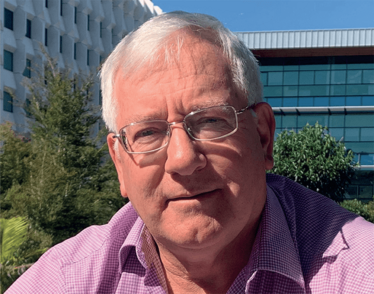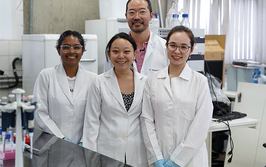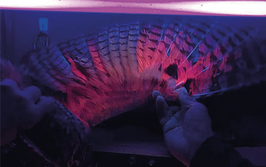My GC×GC Story
Join me on a comprehensive trip down a two-dimensional memory lane – and reflect on the legacy bequeathed by John Phillips
Philip Marriott | | 8 min read | Historical

Philip Marriott
John B. Phillips – in collaboration with Zaiyou Liu – is recognized as the inventor and “father” of comprehensive two-dimensional gas chromatography (GC×GC). His untimely passing in 1999 meant that he never witnessed GC×GC flourish into a new force in ultra-high-resolution GC analysis. Though not widely published, his research spanned multiplex GC, thermal desorption and on-column modulation, and fast GC with thermal modulation – and can be seen as a precursor to what was to come. His spirit of innovation was evidently invested in his former students, such as Janusz Pawliszyn – the inventor of solid-phase microextraction – who studied on-column photochemistry in glass GC columns with John.
I am not sure how many chromatographers got their inspiration to commence GC×GC from hearing John Phillips “wax lyrical” and extol the virtues of this new operating mode he had started working on – but I did. My student Russell Kinghorn and I had been researching the benefits of a longitudinal modulation cryogenic system (LMCS) – an idea I had at the ISCC meeting in Riva Del Garda in May 1994 while listening to Hans Gerd Janssen discuss large volume injection. (But that is another story.) The essence of the LMCS is a cryogenic region encapsulated in a small “shuttle” device that oscillates back-and-forth around a capillary column. The idea was that it would/should allow trapping and rapid re-mobilization of a migrating chromatographic band – a theory we were able to demonstrate.
John had been invited to a chromatography meeting in Sydney, and I was organizing a satellite meeting in Melbourne – the Victorian Separation Science Symposium (1997). This was a good chance to snaffle the speakers who were visiting Sydney. John was eloquent, and very upbeat about this new GC×GC technique. And why wouldn’t he be?! Today – perfectly vindicated – GC×GC has spawned a whole new area of advanced capability in GC analysis. The technique was critically dependent on the process of transferring narrow “cuts” from a first (1D) to a second (2D) column – and to do so with an incredible efficiency, delivering an extremely sharp band to the 2D column. Russell and I must have had the same idea, at the same time; “Surely our LMCS could work as an effective modulator for GC×GC” – we whispered as John spoke. So we dropped everything, and focused on developing the concept of a cryogenic modulator for GC×GC. The rest, as they say, is history – our cryogenic process has proved to be a great enabling modulation mode for GC×GC.
But at that time, John reminded me that we had met before. At Pacifichem in Hawaii, in 1985, when I was at the National University of Singapore. We met at my poster on chemical interconversion processes in GC – research that we are still doing today, but now using GC×GC. A story within a story!
Cryogenic devices and GC×GC modulation
John lived long enough to see his vision taken up by a select group of researchers, but their enthusiasm did not translate into major chromatography companies running with the idea. Tools for doing GC×GC were largely in-house devices or the sweeper interface that Zoex championed. Our cryogenic concept apparently spawned a similar device – the dual jet cryo-system at the heart of the LECO GC×GC commercial system. And with the hardware sorted out, LECO was then charged with developing software control and data presentation/reduction for GC×GC. So at last, GC researchers and industrial users could access a package that offered the full suite of hardware and software required for many research and industrial applications.
How did LECO commence their journey in GC×GC? It is hard to know the inner workings and discussions within a commercial entity, but LECO had already commercialized fast GC-TOFMS technology. And I recall that at the Wintergreen ISCC (1997) meeting there was some excitement about TOFMS for very high throughput GC-MS analysis – and some of us realized that such capability was almost perfectly suited to the acquisition rate demanded of GC×GC. Most users had to be satisfied with FID and other GC detectors – not all correctly engineered for peaks 0.1 s wide. We knew samples were much more complex than a 1D GC analysis suggested – we could see all those extra peaks staring right at us in the GC×GC result! But that also posed a universal and highly unsatisfactory problem: we couldn’t identify those same peaks. All a sceptical observer had to ask was, “What are all those peaks – are they real?” And given that our answer was, “We don’t actually know,” it was easy to dismiss the value of GC×GC. MS had to be a priority.
Putting TOFMS to work for GC×GC
A couple of years later at the Park City ISCC meeting (1999), a few presentations really put GC×GC in the spotlight – but where was MS? A few of us – René Vreuls, Jan Beens, and I – had a serious discussion with Rick Parry (at that time LECO’s Separation Science Product Manager) to beseech LECO to move into GC×GC, based on using their TOFMS technology. We knew such technology would help GC×GC users step up to the next level.
To be honest, I’m not sure if Rick took this idea to LECO or if the company was already deep in discussions regarding GC×GC technology; perhaps all we did was confirm our commitment to GC×GC with TOFMS, giving “extra ammo” for Rick to transmit to LECO. Irrespective, early researchers adapted TOFMS to various modulators as bespoke hyphenated systems; later, LECO adopted GC×GC with TOFMS – much to the delight of our close-knit community.
So, John Phillips’ earlier demonstration of separation of complex petrochemical and atmospherics samples truly was a beacon illuminating the path towards super-high resolution GC×GC.
Then, Don Patterson’s very compelling study of contaminants in human adipose tissue was presented at Wintergreen ISCC in 1997 for trace dioxins following the factory explosion at Seveso. He required the absolute best separation and sensitivity of analysis, and this allowed translation to sampling less of the adipose tissue that was needed to provide a positive screen for exposure. If I recall, he said that it was easier to convince someone to part with a 1 g fat sample than to request upwards of 20 g to achieve the necessary detection limits…
Fast forward – GC×GC today
For many in the GC community, simply seeing a 2D chromatogram plot is sufficient to clearly demonstrate the capabilities of GC×GC – enough to ask, “How do I get a piece of this action?!” And the fact that GC×GC is based firmly on principles of GC means that it can be easily understood in terms of operation and design. There is no “jiggery pokery” required to make it work; apply the technique correctly and it will reward the analyst with both separation and sensitivity.
However, tools to correctly report the hundreds of peaks in our analyses both reliably and precisely are crucial. Getting baselines correct, assigning modulated peaks of a given component to that compound, and being able to do this over a series of replicates or a long time-series analytical study, requires the software engineer to ensure the tools process data correctly. But I would say that the final GC×GC result is clearly better than the significant uncertainty that accompanies a poorly resolved 1D GC result.
There is no reason why every sample that is analysed by 1D GC cannot or should not be applied to GC×GC methodology. All the information available to a 1D GC analysis is still available in GC×GC, but the latter will almost assuredly provide information or details that were not available or evident using a 1D GC method! In other words, the risk/reward equation firmly favors the reward side.
Landmark GC×GC Literature
| Year | Milestone |
| 1991 | First literature report by Liu & Phillips on GC×GC (J Chromatogr Sci) |
| 1992 | Patent on GC×GC |
| 1997; 1998 | Cryogenic modulation in GC×GC (Anal Chem, J High Resolut Chromatogr) |
| 1999 | Robust thermal modulator for GC×GC - review (J High Resolut Chromatogr) |
| 2000 | First publication on dual jet modulator (Jet cooled thermal modulation) (J Sep Sci) |
| 2000 | Flow modulation for GC×GC (Analyt Chem) |
| 2000 | GC×GC×GC (J High Resolut Chromatogr) |
| 2000; 2001 | TOFMS with GC×GC (J High Resolut Chromatogr, Analyt Chem) |
| 2002; 2003 | Diaphragm modulation (J Sep Sci, J Chromatogr A) |
| 2003 | Nomenclature and terminology in MDGC (LC-GC Europe) |
| 2005 | Fast qMS for GC×GC (J Chromatogr A) |
| 2004,7,13 | Tile assignment and classification in GC×GC and data processing; group / class characterisation (J Chromatogr A, Talanta) |
| 2010 | Flow splitting for MS detection (J Sep Sci) |
| 2010; 2012 | Switchable/Selectable/Hybrid 1D / MDGC / GC×GC studies (J Chromatogr A, Analyt Chem) |
| 2013 | Benchmarking of detectors in GC×GC (J Chromatogr A) |
| 2021 | Super-resolved GC×GC analysis (Analyt Chem) |

The killer application?
Many analysts are asked – with respect to a new or alternative technique – “What are the killer applications?” This question was especially pertinent for capillary electrophoresis, which was promoted as an alternative to (or at least could be applied to) many applications suited to HPLC. But I don’t think there was one killer application that demanded the community to move from packed to capillary GC analysis; instead, it just happened as a natural progression in technical capability. Put simply, capillary GC offered much better resolution in a similar time. And so it is with GC×GC. Although the nuances of the technique and the extent of training, familiarization, and method development are acknowledged, better sample characterization is its own reward.
I’d say every lab dealing with volatiles needs GC×GC at the heart of its capabilities – as prior screening of samples or a process using GC×GC allows the analyst to delegate samples to 1D GC, GC-MS, and so on, as the specific analysis demands.
In fact, GC×GC offers a unique generic capability that simply has no analogy in 1D GC. And that’s the opportunity to use clustering of compounds in the 2D separation space to simplify data processing, sample-to-sample comparisons, and process interpretation for sample analysis. This might be a “killer capability,” rather than a single application. With the ability to essentially “see” all the important compounds in most samples – especially for non-target applications – the analyst is free to apply whatever interpretation they require to their data, “without let or hindrance.”
Thus, GC×GC has spread its wings. Though certainly not lacking in imagination, I doubt John would have guessed – or dared dream – of the legacy that he bequeathed to the GC community.
Professor in the School of Chemistry, Monash University, Melbourne, Australia

















